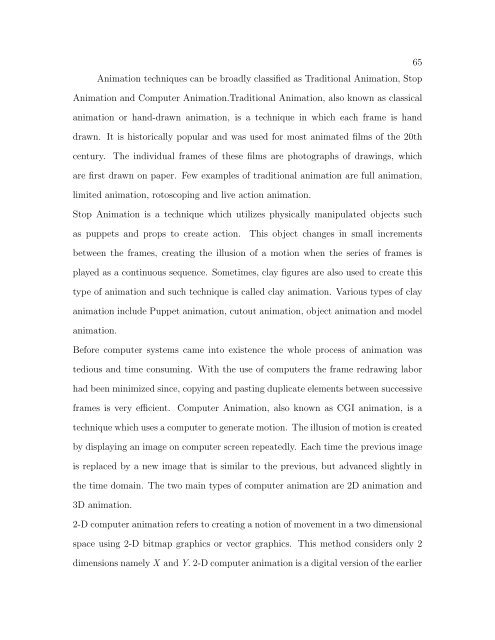A COMPARISON AND EVALUATION OF MOTION INDEXING ...
A COMPARISON AND EVALUATION OF MOTION INDEXING ...
A COMPARISON AND EVALUATION OF MOTION INDEXING ...
You also want an ePaper? Increase the reach of your titles
YUMPU automatically turns print PDFs into web optimized ePapers that Google loves.
Animation techniques can be broadly classified as Traditional Animation, Stop<br />
Animation and Computer Animation.Traditional Animation, also known as classical<br />
animation or hand-drawn animation, is a technique in which each frame is hand<br />
drawn. It is historically popular and was used for most animated films of the 20th<br />
century. The individual frames of these films are photographs of drawings, which<br />
are first drawn on paper. Few examples of traditional animation are full animation,<br />
limited animation, rotoscoping and live action animation.<br />
Stop Animation is a technique which utilizes physically manipulated objects such<br />
as puppets and props to create action. This object changes in small increments<br />
between the frames, creating the illusion of a motion when the series of frames is<br />
played as a continuous sequence. Sometimes, clay figures are also used to create this<br />
type of animation and such technique is called clay animation. Various types of clay<br />
animation include Puppet animation, cutout animation, object animation and model<br />
animation.<br />
Before computer systems came into existence the whole process of animation was<br />
tedious and time consuming. With the use of computers the frame redrawing labor<br />
had been minimized since, copying and pasting duplicate elements between successive<br />
frames is very efficient. Computer Animation, also known as CGI animation, is a<br />
technique which uses a computer to generate motion. The illusion of motion is created<br />
by displaying an image on computer screen repeatedly. Each time the previous image<br />
is replaced by a new image that is similar to the previous, but advanced slightly in<br />
the time domain. The two main types of computer animation are 2D animation and<br />
3D animation.<br />
2-D computer animation refers to creating a notion of movement in a two dimensional<br />
space using 2-D bitmap graphics or vector graphics. This method considers only 2<br />
dimensions namely X and Y. 2-D computer animation is a digital version of the earlier<br />
65
















